As I discussed yesterday in Anxiety, Yoga and the Front Body, supported forward bends can be wonderfully quieting and soothing. You can use these poses to calm yourself when you’re feeling anxious or to turn inward when you’ve been over-stimulated. However, you do need to set up for them properly. By that I mean that the poses need to be completely comfortable. If they’re not completely comfortable for you, they’re going to be irritating and maybe even aggravating, which defeats the whole purpose of practicing them.
To be comfortable in these poses, you need to:
- Pick the seated position that is best for your body (crossed legs, straight legs or wide angle legs). Experiment and see which of the three poses described below are most effective for you.
- Choose the propping (bolster, pillows, stack of blankets or chair) that is truly comfortable for you. Be honest with yourself about the height you need to be comfortable, rather than imitating a photograph.
If your hips are more flexible than the backs of your legs, you might prefer sitting with crossed legs (Sukasana) as in the following two photos.
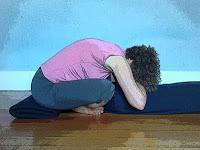
 Unless you are super flexible, start by sitting with crossed legs on a height, such as a folded blanket, with the bolster, stack of blankets, or chair in front of you. Then, bending from your hip joints without rounding your back, slowly fold forward. When you reach the full extension of your spine, allow your back to gently round as you come down toward the prop. (If rounding irritates your lower back, do the version with the chair and keep your back straight.)
Unless you are super flexible, start by sitting with crossed legs on a height, such as a folded blanket, with the bolster, stack of blankets, or chair in front of you. Then, bending from your hip joints without rounding your back, slowly fold forward. When you reach the full extension of your spine, allow your back to gently round as you come down toward the prop. (If rounding irritates your lower back, do the version with the chair and keep your back straight.)Fold your arms, with elbows out to the sides, and stack your hands on the prop. Then rest your forehead on your hands, gently tugging your forehead skin down towards your eye. Stay for two or three minutes (or longer if it's delicious), switching the cross of your legs half way through.
Straight Legs Forward Bend
If your legs are more flexible than your hips (this is somewhat atypical but some people—like me—have this body type), you might find it easier to do the pose with straight legs (Paschimottanasana), as in the next two photos.
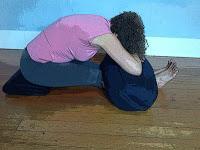
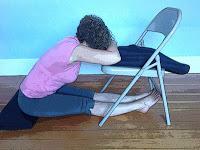 Unless you are super flexible, start by sitting with straight legs on a height, such as a folded blanket, with the bolster, stack of blankets on top of your legs or chair over them. Then, bending from your hip joints without rounding your back, slowly fold forward. When you reach the full extension of your spine, allow your back to gently round as you come down toward the prop. (If rounding irritates your lower back, do the version with the chair and keep your back straight.)
Unless you are super flexible, start by sitting with straight legs on a height, such as a folded blanket, with the bolster, stack of blankets on top of your legs or chair over them. Then, bending from your hip joints without rounding your back, slowly fold forward. When you reach the full extension of your spine, allow your back to gently round as you come down toward the prop. (If rounding irritates your lower back, do the version with the chair and keep your back straight.)Fold your arms, with elbows out to the sides, and stack your hands on the prop. Then rest your forehead on your hands, gently tugging your forehead skin down towards your eye. Stay for two or three minutes (or longer if it is delicious), keeping your legs lightly active.
Wide Angle Forward Bend
People who are relatively flexible in both the hips and legs often find wide angle legs (Upavistha Konasana) the most comfortable position for a forward bend, as shown in the next two photos. Unless you are super flexible, start by sitting with wide angle legs on a height, such as a folded blanket, with the bolster, stack of blankets, or chair in front of you. Then, bending from your hip joints without rounding your back, slowly fold forward. When you reach the full extension of your spine, allow your back to gently round as you come down toward the prop. (If rounding irritates your lower back, do the version with the chair and keep your back straight.)
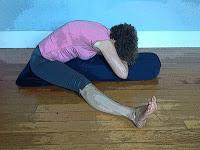
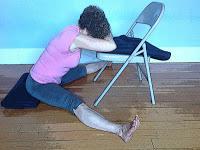 Fold your arms, with elbows out to the sides, and stack your hands on the prop. Then rest your forehead on your hands, gently tugging your forehead skin down towards your eye. Stay for two or three minutes (or longer if it is delicious), keeping your legs lightly active.
Fold your arms, with elbows out to the sides, and stack your hands on the prop. Then rest your forehead on your hands, gently tugging your forehead skin down towards your eye. Stay for two or three minutes (or longer if it is delicious), keeping your legs lightly active.Sequencing
Of course, there is no reason why you can’t do more than one of these poses or all three. And by doing more than one pose, you’ll increase the quieting effects. If I were to sequence them, I do them as follows:
- Seated Crossed Legs Forward Bend (Sukasana)
- Wide Angle Forward Bend (Upavistha Konasana)
- Straight Legs Forward Bend (Paschimottanasana)
 Finally, some people just do not enjoy the effects of a long forward bend; they find that the poses elicit an unpleasant, heavy feeling that is kind of deadening rather than soothing. If that’s true for you, supported inverted poses (see Just In Time for the Holidays: Inverted Poses) may be better options. Remember, when working with yoga for emotional wellbeing, your own reactions to the poses should be your guide.
Finally, some people just do not enjoy the effects of a long forward bend; they find that the poses elicit an unpleasant, heavy feeling that is kind of deadening rather than soothing. If that’s true for you, supported inverted poses (see Just In Time for the Holidays: Inverted Poses) may be better options. Remember, when working with yoga for emotional wellbeing, your own reactions to the poses should be your guide.

